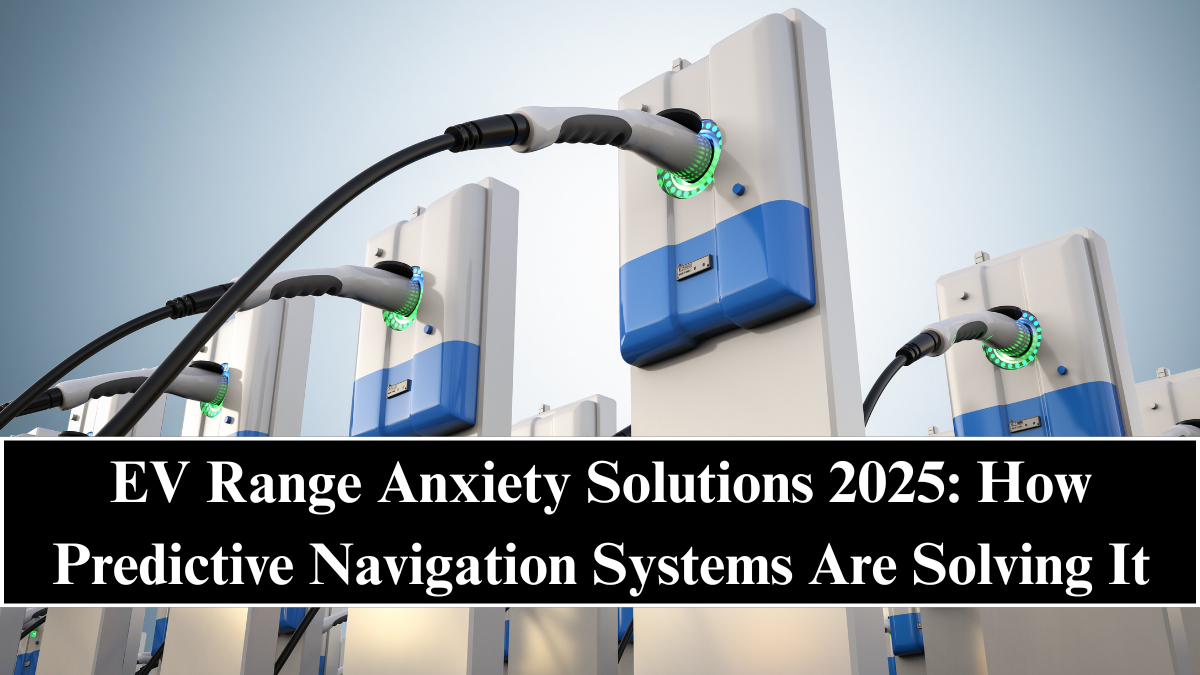One of the biggest psychological barriers to electric vehicle adoption has been range anxiety — the fear of running out of charge before reaching a destination. In 2025, that anxiety is finally fading, thanks to AI-driven predictive navigation systems, real-time data integration, and expanded charging infrastructure. These technologies now give EV drivers the confidence to travel long distances without worrying about the next plug point.

Understanding the Range Anxiety Problem
Range anxiety isn’t just about the actual distance an EV can travel — it’s about uncertainty. Drivers worry about traffic, weather, terrain, and charging availability, all of which affect battery range. In earlier EV generations, range estimates were often inaccurate, leaving users uncertain about whether they could reach their next stop safely.
In 2025, however, smart navigation algorithms and AI analytics have turned this challenge into a data-driven solution, ensuring precise trip predictions and dynamic updates on-the-go.
Predictive Navigation: The Smart Solution
Modern EVs now use predictive navigation systems powered by AI and cloud computing to provide real-time, context-aware range estimates. These systems take into account multiple variables, such as:
-
Road gradients and driving style
-
Weather and temperature conditions
-
Traffic density and stop-start patterns
-
Charging station availability and wait times
The result is a constantly updated route plan that adjusts dynamically to optimize energy use and charging stops. For instance, if a driver encounters unexpected congestion, the car automatically recalculates the route with optimal charging points factored in.
Leading EV brands like Tesla, Hyundai, Rivian, and Mercedes-Benz now integrate predictive navigation as a standard feature in all 2025 models.
AI-Powered Battery and Route Optimization
Artificial intelligence plays a pivotal role in reducing range anxiety. Advanced systems use machine learning to analyze historical driving patterns and environmental data, helping predict how much charge will actually be consumed.
For example:
-
Tesla’s Trip Planner uses route history and elevation data to suggest the most efficient travel path.
-
Hyundai’s IONIQ 6 SmartSense adjusts energy output and regenerative braking based on real-time driving conditions.
-
Mercedes’ MBUX Navigation with Electric Intelligence calculates the best route with optimal charging intervals automatically.
This intelligent route optimization means EVs can now plan charging breaks precisely where they’re needed, cutting both travel time and uncertainty.
Growth of Charging Infrastructure: From Gaps to Networks
In 2025, the world has seen a dramatic expansion in fast and ultra-fast charging networks:
-
India: 10,000+ public chargers, with expressway networks linking major cities.
-
Europe: High-power 350 kW Ionity stations every 60 km on major routes.
-
U.S.: Tesla’s Supercharger and NEVI-funded networks providing coast-to-coast coverage.
In addition, smart charging apps integrate data from multiple providers, displaying real-time station availability and pricing — eliminating the guesswork that once plagued EV travel.
With these developments, an EV road trip is now as straightforward as a traditional fuel stop journey — only quieter and cleaner.
Integration with Smart Devices and Voice Assistants
Another major breakthrough in 2025 is cross-platform integration. EVs now sync seamlessly with:
-
Smartphones and wearables for live range updates.
-
Voice assistants like Alexa Auto and Google Assistant for real-time charging guidance.
-
Cloud ecosystems (Apple Maps EV, Android Auto EV Mode) for multi-device trip planning.
Drivers can start a route plan from home, send it to their car, and receive updates en route — ensuring maximum convenience and minimal uncertainty.
The Role of Digital Twins and Simulation Technology
EV manufacturers are also leveraging digital twin technology to simulate real-world battery performance before vehicles hit the market. These simulations allow automakers to optimize energy efficiency under countless driving conditions, giving drivers a more accurate range estimate from day one.
This means EVs are not just smarter in real time — they’re pre-optimized through millions of virtual miles before production even begins.
The Future: Zero Range Anxiety
By 2025, “range anxiety” is rapidly transforming into “range confidence.” The combined power of AI, predictive modeling, and real-time infrastructure data is enabling the next phase of electric mobility — self-managing vehicles that plan, optimize, and execute journeys with minimal driver input.
The future is already arriving with:
-
Predictive charging queues that reserve charging slots before you arrive.
-
AI co-pilots that learn your routines and pre-schedule home or office charging.
-
Bidirectional power systems (V2G/V2H) turning EVs into backup energy sources during long trips.
The fear of running out of battery is fading fast — replaced by the assurance of data-backed reliability.
FAQs
What is EV range anxiety?
It’s the fear of an electric vehicle running out of battery before reaching a charging station.
How does predictive navigation help reduce range anxiety?
It uses AI, GPS, and real-time data to predict energy consumption and identify optimal charging stations along your route.
Which EVs offer predictive navigation in 2025?
Models from Tesla, Hyundai, Rivian, BMW, Mercedes-Benz, and Kia now come with integrated predictive route planning.
Can AI improve EV battery performance?
Yes, AI continuously learns from driving behavior to improve energy efficiency, battery health, and charging strategy.
Is range anxiety still a concern in 2025?
Far less than before. With expanded charging infrastructure and AI-powered route planning, EV drivers now travel confidently across long distances.
Click here to know more.
